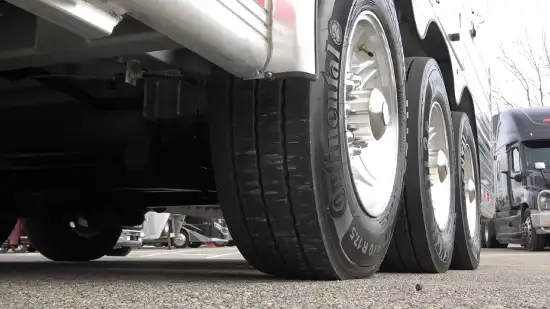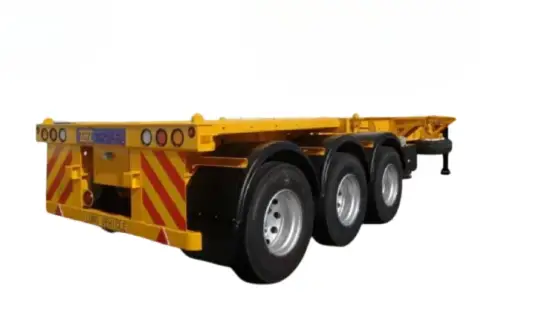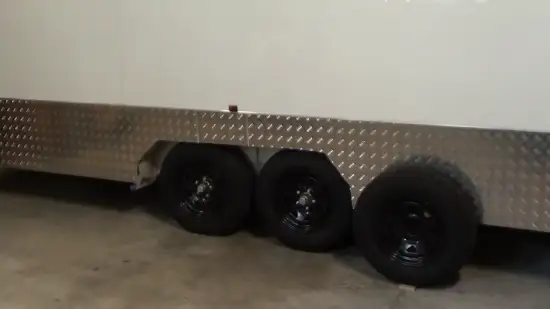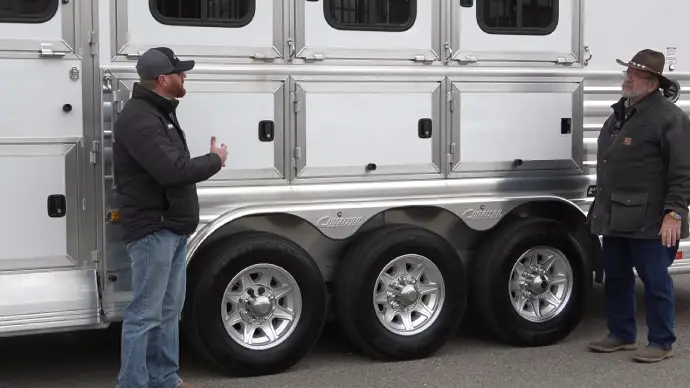Last Updated on July 10, 2023
Imagine you are driving a dual axle trailer with three tires on each axle, and suddenly one of the tires on the same axle blows out. What would you do? This situation is not uncommon and can happen to anyone while driving a trailer.
In this situation, the question arises, can you drive a dual-axle trailer with only three tires?
While operating with only three tires is manageable, you must be aware of the inherent dangers and take the necessary measures to prevent mishaps. An additional strain on the remaining axle and wheel bearings can cause irreversible harm, putting you, your passengers, and other road users in danger.
Find out how to stay safe on the road by exploring essential considerations and actions. This information is critical in protecting you and others. Today’s focus is on driving with one less tire. Let’s discuss this important topic in detail.
What to Consider When Driving a Dual Axle Trailer With Three Tires?

In order to drive a dual-axle trailer with three tires, several factors need to be considered.
- Tire Condition and Inflation
- Weight Distribution
- Driving Speed and Style
- Road Conditions
- Windy Conditions
- Backup Plan
- State and Legal Requirements
1. Tire Condition and Inflation
Ensuring the tire on a dual axle trailer is in optimal condition with adequate tread depth and properly inflated to the recommended pressure is crucial in preventing potential blowouts and ensuring safe vehicle operation.
Neglecting these factors can lead to serious accidents on the road, causing harm not only to the driver but also to other road users. Therefore, remember to regularly inspect the tires for any signs of wear, damage, or bulges that may compromise the tire’s integrity.
Maintaining the tire’s recommended pressure is also essential in preventing blowouts. When tires are overinflated, the center wears out sooner, while underinflated tires flex excessively, causing overheating and potential blowouts.
2. Weight Distribution
Maintaining proper weight distribution between the two axles of a trailer is crucial for ensuring safe and stable operation on the road. Overloading the trailer or unevenly distributing the weight can cause excessive stress on one tire or axle, resulting in losing control.
Maintaining balance and stability requires distributing the load evenly, so heavier items should go in the center and lighter items towards the edges. To ensure that the weight is properly secured and evenly distributed within the trailer, it is recommended to use tie-downs or straps to hold the cargo in place.
The weight distribution should also be regularly checked throughout the trip, especially when loading or unloading.
3. Driving Speed and Style
To compensate for increased stress on the remaining tire and axle, driving at reduced speeds and exercising caution during acceleration, deceleration, and turns is recommended. With only three tires on a dual-axle trailer, it is important to maintain control of the vehicle by driving at a reduced speed.
This will help prevent further damage to the remaining tire and axle. Acceleration, deceleration, and turning with caution are also crucial for maintaining vehicle control, as we discussed earlier.
To further ensure the safety of passengers and cargo, avoiding sudden maneuvers and aggressive driving is recommended. These driving styles can exacerbate the remaining tire and axle stress, leading to further damage and potential accidents.
4. Road Conditions
As you drive a dual-axle trailer with three tires, the condition of the road being traveled should be taken into consideration. Rough or uneven surfaces can further strain the remaining tire and axle, potentially leading to damage or even a blowout. Whenever possible, choose smoother, well-maintained roads.
This minimizes stress on the trailer and ensures a safer driving experience. In addition to being cautious of rough roads, drivers should also watch for potential hazards such as potholes, debris, or speed bumps.
These obstacles can cause damage to the remaining tire and axle and may even cause the trailer to become unstable.
5. Windy Conditions
Navigating a dual-axle trailer with three tires in gusty winds requires heightened caution and awareness of potential air turbulence. The larger surface area of the trailer significantly increases wind resistance, making it more difficult to control the vehicle.
Reducing speed and maintaining a firm grip on the steering wheel when driving in these conditions is essential. Passing or being passed by large vehicles can also create air turbulence, which can be dangerous for drivers of dual-axle trailers with three tires.
Note: You must exercise extra caution to control your vehicle in these situations.
6. Backup Plan
In addition to being prepared for windy conditions on a dual axle trailer with three tires, ensure you have a backup plan in case of further tire damage. This is especially crucial when traveling long distances or through remote areas where repair facilities may be scarce.
One way to ensure you have a backup plan is to carry spare tires suitable for your trailer and the necessary tools to change them if needed. It is also important to familiarize yourself with the location of nearby service stations or repair facilities in case a tire change is not possible or other issues arise.
By being prepared, you can avoid being stranded on the side of the road and ensure a safe and successful trip. The following table serves as a checklist for creating a comprehensive backup plan:
| Item | Importance |
|---|---|
| Spare tires | Essential |
| Tire changing tools | Essential |
| Tire pressure gauge | Essential |
| Lug wrench | Essential |
| Jack | Essential |
7. State and Legal Requirements
Legal requirements are essential for safe and legal vehicle operation with multiple axles and tires. State laws and regulations governing trailer operation, registration, and tire requirements are important to know. When it comes to driving a dual-axle three-tire trailer, here are some important legal requirements to keep in mind:
- Check state laws: Before hitting the road, it is important to check the laws in your state regarding the operation of a dual axle trailer with three tires. Some states may require special licensing or registration, while others may have specific tire requirements.
- Maintain a valid driver’s license: It is important to have a valid driver’s license that is appropriate for the type of vehicle you are operating. Additionally, it is important to have insurance coverage for the trailer to ensure that you are protected in the event of an accident.
- Adhere to specific regulations: Depending on the type of trailer you are operating, there may be specific regulations that you must adhere to. If you’re hauling hazardous materials, you might have to follow extra regulations to keep yourself and others safe.
Associated risks of operating a triple-tired dual-axle trailer

There are several associated risks when driving a three-tire trailer with dual axles. The following are some of the most common:
One: Poor Tire Condition Can Cause a Blowout
Maintaining adequate tire condition is imperative, as subpar maintenance can lead to a tire blowout while towing a three-wheeled dual axle trailer. The consequences of a blowout can be catastrophic, often resulting in a loss of control over the vehicle and a potential accident.
Here are three examples of how poor tire condition can cause a blowout:
Underinflated tires: When a tire is underinflated, it has a larger surface area in contact with the road. This increased friction generates more heat, which can cause the tire to overheat and eventually fail. Additionally, an underinflated tire is more prone to damage from potholes and other road hazards.
Overloaded tires: When a tire is overloaded, it is subjected to more stress than it was designed to handle. This stress can cause the tire to develop weak spots, eventually leading to a blowout. Overloading a tire can also cause it to overheat, as the increased weight generates more friction between the tire and the road.
Worn tires: As a tire wears down, its ability to grip the road decreases. This can make it more difficult to steer and stop the vehicle, especially in wet or slippery conditions. Aside from that, worn tires are more prone to punctures and other damage, which can lead to a blowout.
Two: Difficulty Driving on Rough Roads
Navigating rough roads can be challenging for drivers due to uneven terrain and potential hazards. A three-wheeled dual-axle trailer can exacerbate this challenge, as the extra weight can cause the trailer to bounce and sway, making it difficult to maintain control.
This is especially true on roads with potholes, rocks, or other obstacles that can cause the trailer to bounce and shift unexpectedly. To mitigate these difficulties, drivers should take extra precautions when driving on rough roads with a dual-axle trailer.
It may involve slowing down, avoiding sudden movements, and using caution when turning or braking. Drivers should also ensure the trailer is properly loaded and balanced to reduce the risk of tipping or swaying.
Three: No Spare Tire Leads to Potential Stranding
Driving without a spare tire is like going on a long hike without a water bottle; it leaves you vulnerable to potential stranding in case of a flat tire.
Particularly if you’re hauling a triple-tire trailer with two axles. A flat tire on a dual axle trailer poses a significant problem, as the remaining tires will bear an increased load, which can cause them to overheat and fail as well.
This scenario can be especially dangerous when driving on rough or unpaved roads, where tire damage is more likely to occur.
To avoid the potential for stranding, ensuring that your dual axle trailer has a spare tire is essential. This spare tire should be in good condition and properly inflated, as an underinflated or damaged spare tire may not be useful when needed.
Can you drive a trailer with a missing tire?
When one of the tires on a dual-axle trailer is missing, the trailer can still be safely transported for a short distance as long as the remaining tires are fully inflated and in good condition. Although the trailer’s load capacity shrinks, the remaining tires must bear a heavier load.
This means the driver should reduce their speed and avoid overloading the trailer. In addition, the driver should also inspect the remaining tires for any signs of damage or wear and replace them if necessary to prevent any further damage or accidents.
Do I Need to Rotate Tires on a Dual Axle Trailer?

Rotating the tires of a double axle trailer is unnecessary to maintain optimal tire performance and lifespan. This is because each tire is evenly weighted and aligned with its respective axle, which prevents uneven wear and tear.
To maintain even tread wear, trailer tires are not rotated like automobile tires, which are rotated to balance wear at the steer positions and prevent uneven wear at the drive positions. Therefore, rotating the tires on a trailer may not provide any significant benefits regarding tire performance or lifespan.
Moreover, rotating the tires on a dual-axle trailer can be a cumbersome and time-consuming task. This is because the trailer must be jacked up, and each tire must be removed and repositioned to its new location.
This process can be complicated by the added weight and size of the trailer, making it challenging for individuals needing proper equipment or expertise.
Safe Trailer Driving: Maintaining All Tires on a Dual-Axle Trailer
Dual-axle trailer driving with only three tires is arguably not recommended as it comes with potential risks. It is important to ensure that the remaining tires are in good condition and properly inflated and to balance the weight distribution on the trailer to prevent excess strain on the remaining tires.
Dual axle trailer tire rotation is crucial to ensure even wear and prolong their lifespan. A common misconception is that driving a dual-axle trailer with three tires is safe and acceptable, but this is false.
The added strain on the remaining tires can cause them to wear down more quickly, leading to a blowout while on the road. If the missing tire is on the same axle as another tire carrying a heavy load, this increases the risk of tire failure.
So, to prevent potential accidents and breakdowns, it is important to maintain all tires on a dual-axle trailer for maximum safety.



